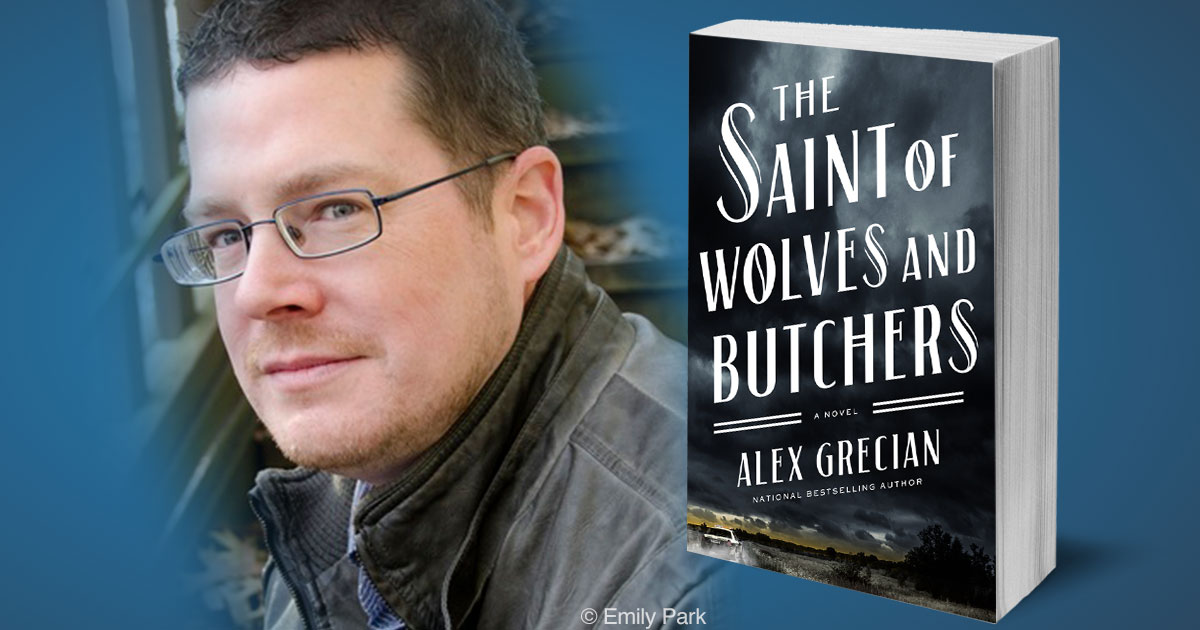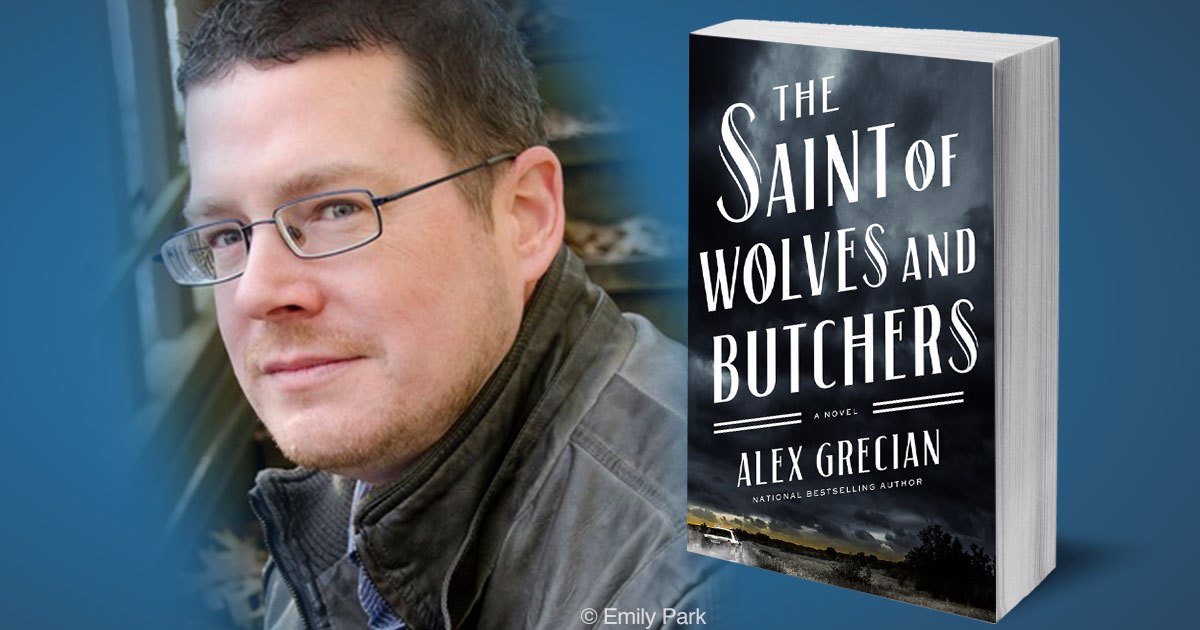Featured Author: Alex Grecian

Alex Grecian’s newest book is about the hit the shelves. The Saint of Wolves and Butchers is a dark, twisty page-turner that will suck you in at once, and won’t let you go until you’ve read to the end.
Grecian is best known for his New York Times bestselling series, Scotland Yard’s Murder Squad, set in Victorian England. Now the Topeka native is releasing a contemporary thriller set in Kansas. The Saint of Wolves and Butchers takes readers to rural Kansas where a Nazi doctor, Rudolph Bormann, is hiding in plain sight. Bormann hasn’t given up on evil, he’s just transplanted it to the heartland. When a Holocaust survivor recognizes Bormann and bodies begin turning up, Travis Roan and his Tibetan mastiff come to Kansas in pursuit. State Trooper Skottie Foster finds herself drawn into the action, putting her life and her family at risk in the pursuit of justice.
Grecian shared that while The Saint of Wolves and Butchers is his first published novel set in Kansas, he wrote two other novels set in Kansas that have not yet been published. He said writing a book set in a closer locale has its advantages.
“It’s nice to be able to drive somewhere and walk around where your characters are going to be. I can add details from my own experience and perspective,” Grecian said. “I also think Kansas is largely overlooked in literature. Who knows? At some point I may go ahead and publish those first books (after some heavy revision) and start a connective universe of novels that feature this area of the country.”
A closer location and contemporary setting don’t mean that Grecian skimped on research. He put in just as much time and work for this novel as he did to write his historical thrillers set in England.
“I really thought I would save myself time and trouble by setting a book near my home,” Grecian said. “My historical novels have all taken an enormous amount of research, and even though I love doing research I was ready to write something fast and fun. As it turns out the time and place a book is set in doesn’t make much difference; there are no shortcuts.”
Readers will be able to tell how much work Grecian put in. The novel is not only thrilling and well-paced, it’s also authentic down to the details.
“Aside from needing to know about concentration camps and firearms and Kansas history, I found it necessary to spend time with the Highway Patrol, talk to actual Nazi hunters and a coroner who flies his own plane to crime scenes,” Grecian said. “I even learn about the flora and fauna native to my home state, something I’d never given much thought to before. Good thing I love to research my subjects so thoroughly, because it seems that part of the job will always require about the same amount of time.”
Read on for the full text of my interview with the author and links to books by Grecian and related titles in our library collection.
An Interview with Alex Grecian
The Saint of Wolves and Butchers is your first novel that takes place in the United States, and you chose your home state of Kansas as its setting. What inspired you to place this particular story in Kansas?
My first two unpublished novels were set in and around Kansas. It’s nice to be able to drive somewhere and walk around where your characters are going to be. I can add details from my own experience and perspective. I also think Kansas is largely overlooked in literature. Who knows? At some point I may go ahead and publish those first books (after some heavy revision) and start a connective universe of novels that feature this area of the country.
Your Scotland Yard Murder Squad series demonstrates your skill as a researcher—the books are historically accurate representations of London in the late 1800s. Tell us a little about the research you put in for SWB. How was it different writing a contemporary thriller?
The biggest difference between The Saint of Wolves and Butchers and my other books is that I was able to talk to experts in various fields, rather than relying on books and maps for most of my information. I really thought I would save myself time and trouble by setting a book near my home. My historical novels have all taken an enormous amount of research, and even though I love doing research I was ready to write something fast and fun. As it turns out the time and place a book is set in doesn’t make much difference; there are no shortcuts. Aside from needing to know about concentration camps and firearms and Kansas history, I found it necessary to spend time with the Highway Patrol, talk to actual Nazi hunters and a coroner who flies his own plane to crime scenes. I even learn about the flora and fauna native to my home state, something I’d never given much thought to before. Good thing I love to research my subjects so thoroughly, because it seems that part of the job will always require about the same amount of time.
I admire the complexity of the characters in SWB. Readers are in for some twists, with the heroes and villains sometimes taking on unexpected roles. Do you develop character sketches and such to get into the minds of your characters, or do you let them develop as you discover the story?
I always start with a rough idea of who a character is, what she wants from life and from the situation that’s going to play out over the course of a book. But I don’t like to know too much about her because we discover people through their actions and I believe that’s the most useful way to discover a character, too. It’s a good day at the keyboard if a character does something surprising, something I had no idea they might do. I’ve said this a lot, but if I don’t know what’s going to happen next, then hopefully the reader won’t either.
Skottie Foster is a native Kansan, and a woman of color, who has been living in Chicago and has just returned to native soil. You not only wrote one of your main characters a woman of color, you also addressed the issue of race in her experience within the narrative. As a librarian I see book discussion gold, there. Did you set out to use fiction as a vehicle to prompt discussion of race, and the experience of people in color in Kansas, or was it a more organic development as you wrote the story?
I always try to portray strong women, even in my graphic novel work. In my novels that’s usually been in the context of Victorian England, though, which is a different culture and imposes different limitations on a character, so it was exciting to return to our contemporary American society and the expectations we have. At its core this book is about isolation and identity and empathy (or the lack of it), and I needed a positive counterpoint to my villain’s malevolence, someone who can bring a very different perspective compared to everyone else. Most of the other characters are, of necessity, white men. So a woman of color is in a unique position, in that she’s going to come into the situation in this book with higher stakes than a white man would. I was really frightened for a long time, worried that I wasn’t qualified to write from that narrative point of view, but Skottie felt so fully formed to me that I couldn’t see a way to write the story without her. Obviously I haven’t had the experience of being a person of color, but I can listen and empathize and be sensitive to that experience. I hope she feels credible to readers.
You told Kelly Gibson of Topeka Magazine that you will be writing a sequel, and readers will see Bear again! Can you tell us a bit about the forthcoming book?
I do have a sequel planned. I hope readers like this book enough that they’ll want to see more of these characters. In The Merchant of Skin and Bone (my working title), Skottie and Travis (along with his dog Bear) will travel to a remote town in Alaska where a single fingerprint has been found at a murder site. That fingerprint belongs to the man who used to own Bear. Years ago this man removed Bear’s vocal chords and slit Travis’s throat, leaving him for dead. Travis wants revenge and Skottie wants to stop another murder from happening. There’s a little bit of a role reversal between them as they hunt this criminal. But nothing about Bear has changed. He’s still lovable.












